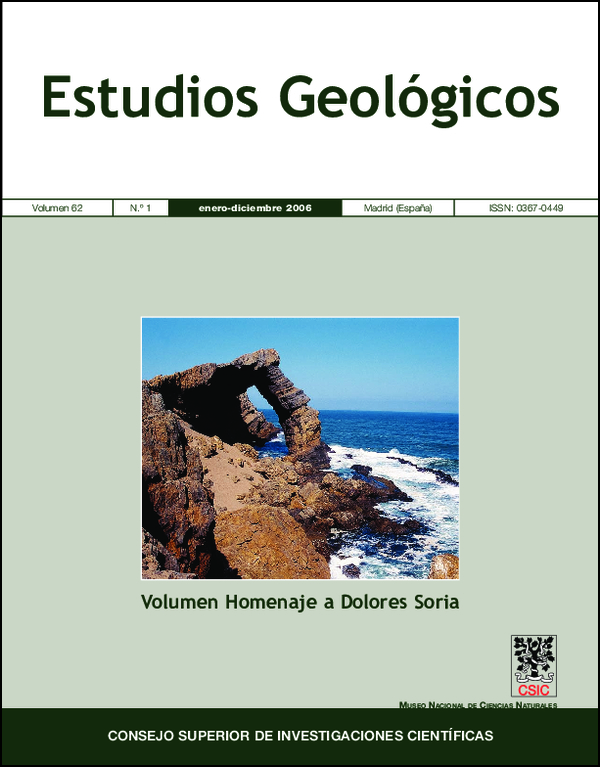Otroacizzia soriae sp. nov., a new Miocene psyllid (Insecta, Hemiptera, Psyllidae) from Dominican amber
DOI:
https://doi.org/10.3989/egeol.0662119Keywords:
amber, Miocene, insect, Psyllidae, Otroacizzia, sp. nov., Dominican RepublicAbstract
new species of the fossil genus Otroacizzia Klimaszewski, 1996 (Hemiptera, Psyllidae) is described as Otroacizzia soriae sp. nov. on the basis of a female specimen. This species is preserved in mid-Miocene amber from La Toca mines, Dominican Republic. The genus Otroacizzia is the most diverse psylloid genus in Dominican amber, with four known species. The new species differs from the three previously known species by the presence of a subapical dark band in the fore wing from the anterior part of the end of vein Rs to the end of vein Cu1b, which has a gap in the middle of the cell c1. Other differences in the fore wing are the presence of a strongly curved vein Cu1b and a cell c1 clearly longer than cell m1. Finally, the antennal segment 3 of the new species is one and a half times longer than segment 4.
Downloads
References
Ansorge, J. & Kohring, R. (1995). Insekten aus dem Randecker Maar. Fossilien, 2: 80-90.
Grimaldi, D.A. & Engel, M.S. (2005). Evolution of the Insects. New York: Cambridge University Press, 755 pp.
Hodkinson, I. D. (1980). Present-day distribution patterns of the holarctic Psylloidea (Homoptera: Insecta) with particular reference to the origin of the nearctic fauna. J. Biogeogr., 7: 127-146. doi:10.2307/2844706
Hodkinson, I. D. (1989). The biogeography of the Neotropical jumping plant-lice (Insecta: Homoptera: Psylloidea). J. Biogeogr., 16: 203-217. doi:10.2307/2845257
Jell, P.A. & Duncan, P. M. (1986). Invertebrates, mainly insects, from the freshwater, Lower Cretaceous, Koonwarra Fossil Bed (Korumburra Group), South Gippsland, Victoria. Mem. Ass. Australas. Palaeontols., 3: 111-205.
Klimaszewski, S. M. (1993a). New species of Miocene psyllids (Homoptera, Psylloidea). Acta Biol. Sil., Katowice, 22: 19-29.
Klimaszewski, S. M. (1993b). The structure of hind wings in Psyllodea (Homoptera) and its possible significance in recognizing the relationships within this suborder. Acta Biol. Sil., Katowice, 22: 57-67.
Klimaszewski, S. M. (1995). Succinopsylla dominicana n. gen. n. sp., a new jumping plant louse from the Dominican amber (Insecta: Homoptera, Rhinopsyllidae). Mitt. Geol.-Paläont. Inst. Univ. Hamburg, 78: 189-195.
Klimaszewski, S. M. (1996). New psyllids (Homoptera, Psylloidea) from Dominican amber. Acta Biol. Sil., Katowice, 29: 24-44.
Klimaszewski, S. M. (1998). Further data concerning Dominican amber jumping plant lice (Homoptera, Psylloidea). Acta Biol. Sil., Katowice, 32: 19-27.
Langenheim, J. H. (2003). Plant Resins. Chemistry, Evolution, Ecology, and Ethnobotany. Portland-Cambridge: Timber Press, 586 pp.
Peñalver, E. (1998). Estudio tafonómico y paleoecológico de los insectos del Mioceno de Rubielos de Mora (Teruel). Instituto de Estudios Turolenses Ed., Teruel: 179 pp.
Peñalver, E., Nel, A. & Martínez-Delclòs, X. (1996). Insectos del Mioceno inferior de Ribesalbes (Castellón, España)- Paleoptera y Neoptera poli- y paraneoptera. Treb. Mus. Geol. Barcelona, 5: 15-95.
Qi-bin, L., Yi-min, Y., Wei-da, X. & Yu-rong, X. (1988). An oligocene micropalaeoentomofauna from Gubei District of Shandong and its ecological environment. Acta Micropalaeontol. Sinica, 5: 331-345.
Downloads
Published
How to Cite
Issue
Section
License
Copyright (c) 2006 Consejo Superior de Investigaciones Científicas (CSIC)

This work is licensed under a Creative Commons Attribution 4.0 International License.
© CSIC. Manuscripts published in both the print and online versions of this journal are the property of the Consejo Superior de Investigaciones Científicas, and quoting this source is a requirement for any partial or full reproduction.
All contents of this electronic edition, except where otherwise noted, are distributed under a Creative Commons Attribution 4.0 International (CC BY 4.0) licence. You may read the basic information and the legal text of the licence. The indication of the CC BY 4.0 licence must be expressly stated in this way when necessary.
Self-archiving in repositories, personal webpages or similar, of any version other than the final version of the work produced by the publisher, is not allowed.















